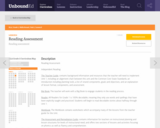
Reading Assessment
Independent Reading
- Subject:
- Education
- Elementary Education
- Material Type:
- Assessment
- Author:
- EngageNY
- Date Added:
- 06/07/2021

Reading Assessment
Independent Reading
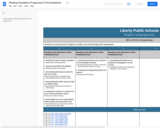
Students are learning how English is written and read through print awareness.

New York City in the 1860s was a mess: crowded, disgusting, filled with garbage. You see, way back in 1860, there were no subways, just cobblestone streets. That is, until Alfred Ely Beach had the idea for a fan-powered train that would travel underground. On February 26, 1870, after fifty-eight days of drilling and painting and plastering, Beach unveiled his masterpiece—and throngs of visitors took turns swooshing down the track. The resource includes a lesson plan/book card, a design challenge, and copy of a design thinking journal that provide guidance on using the book to inspire students' curiosity for design thinking. Maker Challenge: Think about the way most people in your community travel. Invent a new way of traveling around your community that takes into account the following: helpful to the community, economical to those who use it, convenient for users. What would your new travel system look like? Sketch a new design, and then create a physical prototype of the new design to scale. Keep in mind: Where the system travels, how it is powered, why it is helpful to the community, and any features that make it special.
A document is included in the resources folder that lists the complete standards-alignment for this book activity.
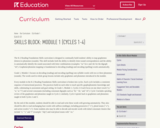
Grade 1: Module 1 of the EL Education K-2 Reading Foundations Skills Block, part of the EL Education K-8 Language Arts Curriculum. The Skills Block provides one hour of structured phonics instruction, to be taught alongside Module Lessons and Labs. For more information on getting started with the K-2 Reading Foundations Skills Block, visit https://curriculum.eleducation.org/about-skills-blocks.
To access this resource, you will need to create a free account for the system on which it resides. This partner uses such data for funding requests to keep their resource growing and up-to-date. Also, these resources are openly-licensed for editing and re-sharing, EXCEPT for certain copyright-protected content (authentic texts, photographs, etc.) within the materials that are from outside sources. This outside content may not be reproduced or distributed (outside the scope of fair use or the EL Education Curriculum Terms of Use) without additional permissions from the content owner.
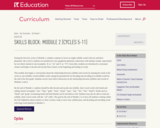
Grade 1: Module 2 of the EL Education K-2 Reading Foundations Skills Block, part of the EL Education K-8 Language Arts Curriculum. The Skills Block provides one hour of structured phonics instruction, to be taught alongside Module Lessons and Labs. For more information on getting started with the K-2 Reading Foundations Skills Block, visit https://curriculum.eleducation.org/about-skills-blocks.
To access this resource, you will need to create a free account for the system on which it resides. This partner uses such data for funding requests to keep their resource growing and up-to-date. Also, these resources are openly-licensed for editing and re-sharing, EXCEPT for certain copyright-protected content (authentic texts, photographs, etc.) within the materials that are from outside sources. This outside content may not be reproduced or distributed (outside the scope of fair use or the EL Education Curriculum Terms of Use) without additional permissions from the content owner.
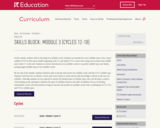
Grade 1: Module 3 of the EL Education K-2 Reading Foundations Skills Block, part of the EL Education K-8 Language Arts Curriculum. The Skills Block provides one hour of structured phonics instruction, to be taught alongside Module Lessons and Labs. For more information on getting started with the K-2 Reading Foundations Skills Block, visit https://curriculum.eleducation.org/about-skills-blocks.
To access this resource, you will need to create a free account for the system on which it resides. This partner uses such data for funding requests to keep their resource growing and up-to-date. Also, these resources are openly-licensed for editing and re-sharing, EXCEPT for certain copyright-protected content (authentic texts, photographs, etc.) within the materials that are from outside sources. This outside content may not be reproduced or distributed (outside the scope of fair use or the EL Education Curriculum Terms of Use) without additional permissions from the content owner.
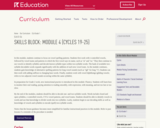
Grade 1: Module 4 of the EL Education K-2 Reading Foundations Skills Block, part of the EL Education K-8 Language Arts Curriculum. The Skills Block provides one hour of structured phonics instruction, to be taught alongside Module Lessons and Labs. For more information on getting started with the K-2 Reading Foundations Skills Block, visit https://curriculum.eleducation.org/about-skills-blocks.
To access this resource, you will need to create a free account for the system on which it resides. This partner uses such data for funding requests to keep their resource growing and up-to-date. Also, these resources are openly-licensed for editing and re-sharing, EXCEPT for certain copyright-protected content (authentic texts, photographs, etc.) within the materials that are from outside sources. This outside content may not be reproduced or distributed (outside the scope of fair use or the EL Education Curriculum Terms of Use) without additional permissions from the content owner.

Sarah E. Goode was one of the first African-American women to get a US patent. Working in her furniture store, she recognized a need for a multi-use bed and through hard work, ingenuity, and determination, invented her unique cupboard bed. She built more than a piece of furniture. She built a life far away from slavery, a life where her sweet dreams could come true. The resource includes a lesson plan/book card, a design challenge, and copy of a design thinking journal that provide guidance on using the book to inspire students' curiosity for design thinking. Maker Challenge: Your school has had an influx of new students and every class seems to be bursting at the seams! You have an additional 10 students just in your classroom alone. Because of this limited space, your school is looking for solutions. They decided that every student is going to get a new desk and chair, but it’s going to be PORTABLE. That way, you can take your desk & chair with you wherever you might go.
A document is included in the resources folder that lists the complete standards-alignment for this book activity.

At a time when most African Americans were slaves, Benjamin Banneker was born free in 1731. Known and admired for his work in science, mathematics, and astronomy, he built a strike clock based on his own drawings and using a pocket-knife at the age of 22. The resource includes a lesson plan/book card, a design challenge, and copy of a design thinking journal that provide guidance on using the book to inspire students' curiosity for design thinking. Maker Challenge: Find a discarded object that can be taken apart. Take apart the item and make your own Things Come Apart arrangement.
A document is included in the resources folder that lists the complete standards-alignment for this book activity.

In order to show the world that the completed Brooklyn Bridge was strong enough, P.T. Barnum and his twenty-one elephants parade across to prove to everyone that the bridge is safe. The resource includes a lesson plan/book card, a design challenge, and copy of a design thinking journal that provide guidance on using the book to inspire students' curiosity for design thinking. Maker Challenge: Build a bridge between two tables or chairs that will hold one elephant per student in the class. Each student designs their own “elephant” using materials in the classroom.
A document is included in the resources folder that lists the complete standards-alignment for this book activity.

Area: Structure & Info Processing
This First Grade unit is the SECOND in the curriculum of three (3) units developed to address the First Grade science standards of the Michigan Science Standards related to Structure and Information Processing.
You have just read the general description for this Phenomenal Science Unit. Before you continue your review, it would be very valuable to our field testing process for the 21 Units of Phenomenal Science for us to gather information about those educators who are reviewing each of the Units. Thank you. Please start your review with this BRIEF SURVEY. Enjoy your review.
Students will observe how plants and animals have offspring and some may look similar but not exactly like their parents/adults. Students will explore how plants and animals have features (external and internal) that allow them to survive, grow, and meet their needs. Students will make many observations about plant and animal parts and how they use their parts to help them survive. They will observe how different plants and animals support their offspring in survival. Students will classify similar animals that can vary in many ways. Students will then apply their understanding of plant and animal survival in order to gain ideas about how to engineer something to solve a human problem. Students will use their knowledge of plant and animal parts to mimic one of these parts to design a solution to a human problem. Students will construct explanations and models for multiple engineering tasks.

Lonnie Johnson tried to create a new cooling system for refrigerators and air conditioners, but instead created the mechanics for one of the top twenty toys of all time, the Super Soaker. From childhood to adulthood, Lonnie had a love for rockets, robots, inventions, and a mind for creativity. He was driven toward innovation through his persistence and passion for problem solving, tinkering, and building. These traits served him well as we went on to work for NASA as an engineer. The resource includes a lesson plan/book card, a design challenge, and copy of a design thinking journal that provide guidance on using the book to inspire students' curiosity for design thinking. Maker Challenge: Students will use materials on hand to invent and design a new toy or game.
A document is included in the resources folder that lists the complete standards-alignment for this book activity.

Emma Lilian Todd was a self-taught engineer who tackled one of the greatest challenges of the early 1900s: designing an airplane. As an adult, typing up patents at the U.S. Patent Office, Lilian built inventions in her mind, including many designs for flying machines. However, they all seemed too impractical. Lilian knew she could design one that worked. She took inspiration from both nature and her many failures, driving herself to perfect the design that would eventually successfully fly. The resource includes a lesson plan/book card, a design challenge, and copy of a design thinking journal that provide guidance on using the book to inspire students' curiosity for design thinking. Maker Challenge: Design a new mode of transportation (air, sea, or ground) or select a current mode of transportation and improve it then use household items to create a prototype of your new or updated invention.
A document is included in the resources folder that lists the complete standards-alignment for this book activity.
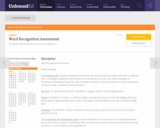
Word Recognition Assessment

Zaha Hadid grew up in Baghdad, Iraq, and dreamed of designing her own cities. After studying architecture in London, she opened her own studio and started designing buildings. But as a Muslim woman, Hadid faced many obstacles. Determined to succeed, she worked hard for many years, and achieved her goals—and now you can see the buildings Hadid has designed all over the world. The resource includes a lesson plan/book card, a design challenge, and copy of a design thinking journal that provide guidance on using the book to inspire students' curiosity for design thinking. Maker Challenge: Identify an area in your school that is very traditional. Redesign it to better fit the needs of the end-users. Then sketch out a new design, and then create a physical prototype of the new design to scale.
A document is included in the resources folder that lists the complete standards-alignment for this book activity.
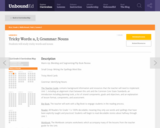
The following language arts objectives are addressed in this lesson. Objectives aligning with the Common Core
State Standards are noted with the corresponding standard in parentheses. Refer to the Alignment Chart for
additional standards addressed in all lessons in this unit.